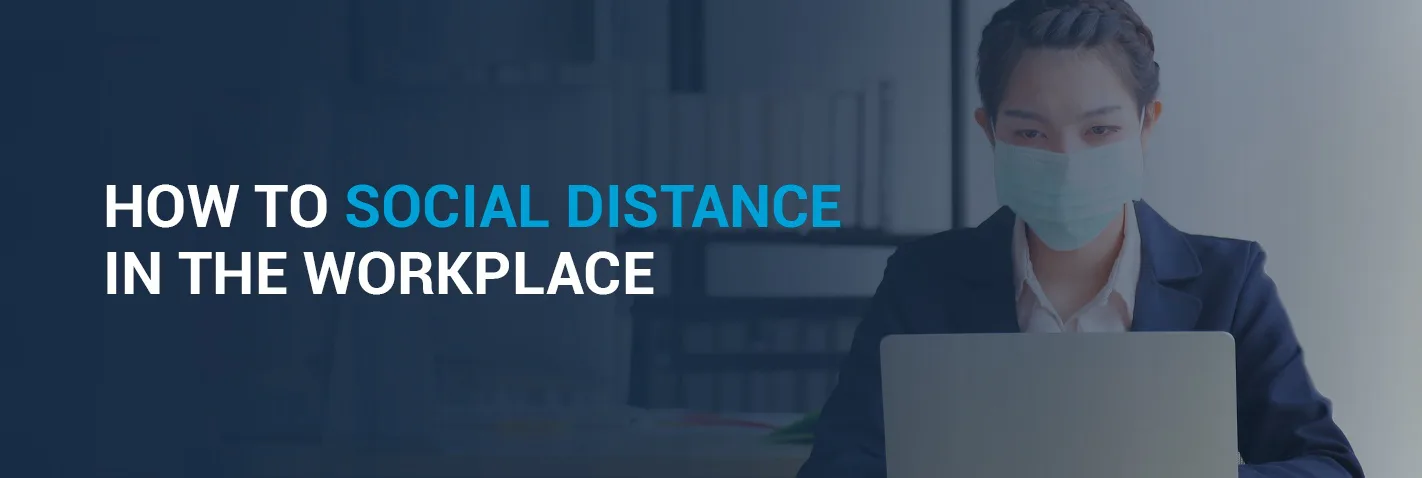

Table of Contents
Although the concept of social distancing, or maintaining space between people, is not new, the first time many people became familiar with the idea was during the COVID-19 pandemic. Social distancing helps to reduce the risk of spread of the novel coronavirus and is believed to be an effective tool for lowering the rates of transmission in communities. While many businesses had to close their physical workplaces during the early phases of the pandemic, some did not or were not able to, as they were considered essential. As areas began the process of reopening, social distancing in the workplace became a requirement.
Your company might need to completely rearrange its layout and its operations to accommodate social distancing and keep your team members safe. Encouraging employees to keep physical distance from others and making it as easy as possible to keep that distance is vital for workers’ and customers’ safety during the pandemic and beyond.
Read the full article or skip to a specific section:
What does social distancing mean? It means maintaining a certain amount of physical distance between yourself and others to slow down the spread of highly infectious diseases. Although one of the most common descriptions of social distancing is keeping at least 6 feet (2 meters) between yourself and other people, there are other ways to maintain social distance. Working from home, avoiding spending time in crowded areas, such as concerts or theaters, and not going out to cafes or restaurants are a few ways to practice social distancing.
There’s evidence from history that social distancing works. For example, during the 1918 influenza pandemic, many cities across the U.S. implemented social distancing measures, such as closing down churches and schools and prohibiting large gatherings of people. Experts believe cities that adopted social distancing measures early on, such as Kansas City, Milwaukee and San Francisco, were able to reduce transmission by up to 50%. The length of time that social distancing measures were in place also had an effect on the mortality rate.
Social distancing is particularly important for reducing the spread of illness when there aren’t known or effective treatments and when vaccines are not available. Although there are vaccines and treatments against the flu, and most people will recover from the common cold with ease, practicing social distancing during the cold and flu season can also be useful for slowing down the spread of those illnesses.
Social distancing in the workplace offers multiple benefits to your company and your employees. For one thing, it helps to keep your team members safe and healthy. Taking steps to reduce the spread of disease means that your employees are less likely to become ill and that your company is less likely to experience an outbreak.
Encouraging or requiring social distancing in the workplace can also help people feel more at ease about coming back to work after a period of working remotely. For employees who need to interact with the public or with a large number of people each day, having social distancing measures in place can help them feel more confident about their safety. When employees feel cared for and respected on the job, they are more likely to stay with an employer.
Having a high employee retention rate saves your company time and money. It is time-consuming and expensive to hire new team members. Having a revolving door of employees is also not good for overall morale, meaning people might be less invested in their jobs and less likely to provide top-quality work or best-quality customer service if they see that their co-workers are regularly quitting.
Social distancing measures also allow your company to remain open during a pandemic. Without the appropriate social distancing efforts, your business might have to close or dramatically limit the services it offers. Encouraging your team and your customers to keep their distance means you can continue to provide your product or service for as long as possible.
Putting social distancing measures into practice can mean changing your company’s approach to operations. It can also mean rearranging the furniture and setting up new workplace guidelines to keep everyone safe. Here are a few social distancing tips to help you.
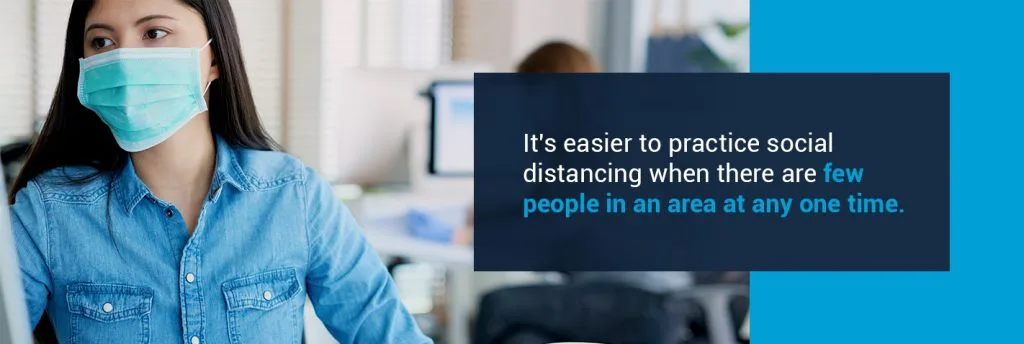

It’s easier to practice social distancing when there are few people in an area at any one time. If a typical, pre-social distancing workday at your business required everyone to be in the office or building during the same hours, it can be worthwhile to introduce staggered shifts. Instead of having everyone come in from 9 a.m. to 5 p.m., have one group of employees come in from 8 a.m. until 3 p.m. and the next group from 4 p.m. until 11 p.m. Another option is to have employees take turns working from home. Employee A can be in the office on Mondays, Wednesdays and Fridays while Employee B works from home. On Tuesdays and Thursdays, Employee B can be in the office while Employee A works from home.
If working from home isn’t feasible for your business or if you have limited hours during which you can operate, there are other ways to stagger shifts. You can ask employees to trade off shifts. For example, if you are a restaurant that is open for takeout on weekend evenings, Employee A can work on the first and third weekends of the month while Employee B works on the second and fourth weekends.
If your company can operate long enough each day to have multiple shifts, be sure you allow time between each shift for thorough cleaning of the workplace. Along with limiting face-to-face interactions between your employees, cleaning shared spaced and high-touch surfaces is important if you want to reduce the transmission of disease.
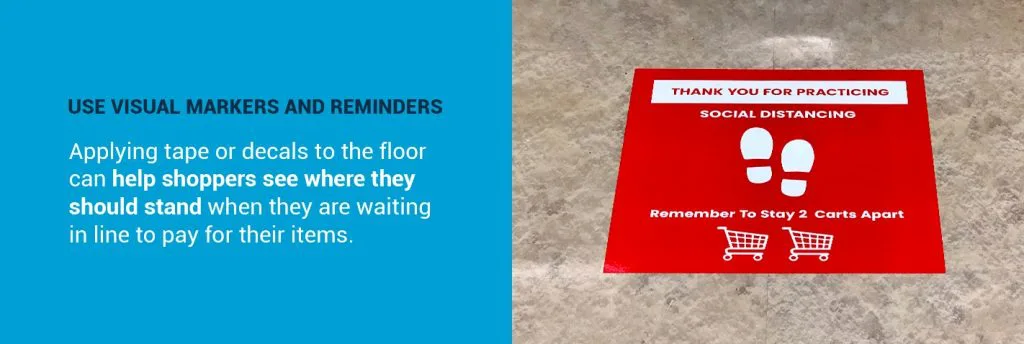

What does 6 feet of space look like in practice? It can be challenging for people to get a sense of whether they are standing too near to another, especially if they don’t have a tape measure handy. Make it easy for your team to see what 6 feet looks like by adding visual markers to the floor or walls. You can use the markers anywhere people might need to form a line, such as outside of the restrooms or when waiting for elevators.
Visual markers are also a must-have if your business is open to the public. Retailers can use pieces of tape to help shoppers see where they should stand when they are waiting in line to pay for their items. Applying tape or decals to the floor can also help people see where to stand when they are picking out items in the store’s aisles.
In addition to visual markers, it can be helpful to hang up signs that gently remind people to practice social distancing and other measures to reduce the spread of illness. Signs on restroom doors can remind people to wash their hands before they leave the room, for instance.
Along with handwashing signs, you can hang up notices to remind people to keep their distance from their co-workers or customers. You can make the signs fun and informative. For example, grocery stores can use images that depict two shopping carts standing between two individuals to help people get a sense of what 6 feet looks like.


In many states, reopening guidelines require businesses to dramatically reduce the occupancy of their buildings or workplaces. Stores that were previously able to hold 300 people might be limited to letting in 75 or 100 people at a time. Restaurants that once had seating for 100 might only be allowed to serve 25 diners at once.
In an era when social distancing is critical, it’s vital that your business goes out of its way to keep track of the number of people who come and go. You don’t need to station a team member at the door to manually count the people enter and exit. Occupancy tracking software and people counters streamline the process for you. The software counts people as they come into the business and as they leave. It gives you a real-time view of the number of people in your building at any time. It also lets you compare the number of people in the workplace to the maximum occupancy allowed. You can then make decisions about admitting more customers, visitors or employees to the building or asking them to wait until occupancy drops.
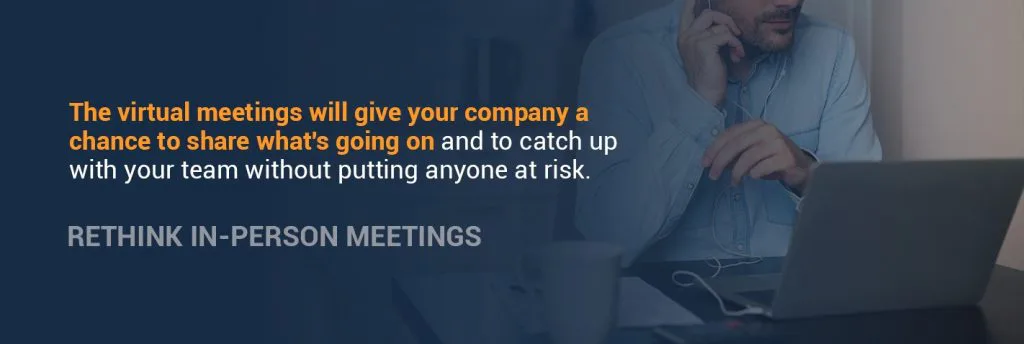

During times when social distancing is needed, avoid in-person meetings as much as possible. If your company typically holds a monthly or weekly all-hands meeting in the conference room or assembly room, consider making it a virtual meeting instead. Employees can log on to the event from their respective workspaces, either in the building or from their homes. The virtual meetings will give your company a chance to share what’s going on and to catch up with your team without putting anyone at risk.
There might be times when an in-person meeting is unavoidable. If that is the case, use extra caution when you prepare for the meeting. Limit the number of people who attend based on the size of the room it will take place in. Space the chairs in the meeting area so that they are at least 6 feet apart. Skip handshakes and other physical forms of greeting at the start and end of the meeting.
To be extra safe, you might ask everyone who needs to attend a meeting in person to wear a mask during it, especially if there will be more than two or three people in the room and especially if it will be tough to keep 6 feet of space between every participant.
Also, limit the length of any face-to-face meetings. Try to keep things under 15 minutes to reduce the risk of exposure and transmission.
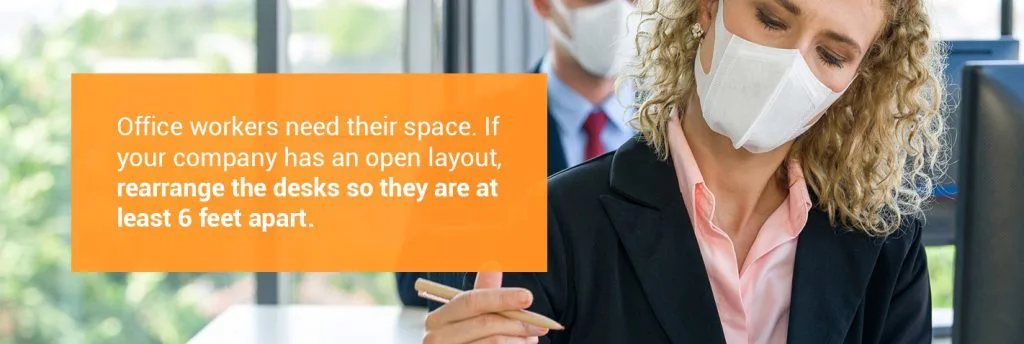

Social distancing isn’t only for when employees might pass each other in the hallways or for customers who are browsing in your store or eating in a restaurant. Office workers also need their space. If your company has an open layout, rearrange the desks so they are at least 6 feet apart. Now is a good time to introduce partitions between work areas, such as cubicle walls. If your company’s office space is already divided into cubicles, consider raising the height of the partitions so they are taller than people. You can add plexiglass barriers to the top of the cubicle walls to extend their height.
If your company’s floor plan previously featured communal work tables, you have a few options for increasing the distance between workers who use them. Option one is to get rid of the tables entirely and to give each team member their own desk. Option two is to keep the tables, but rearrange them so that no one is within 6 feet of another person. Remove chairs and use tape to mark 6-foot areas on each table. It might also be worthwhile to set up barriers between each work area on the tables, as well. If employees are going to continue to share tables, make sure they are cleaned and disinfected throughout the day.
Stores and restaurants can find ways to increase space between work areas, as well. A store that has multiple checkout areas can use every other register. Leaving one register empty between workers helps them keep their distance from each other. It also helps to protect customers, as they are not lining up too close to shoppers in the queue next to them.
Restaurants that have multiple seating areas can limit the number of areas they use at once. Limiting seating areas will most likely be necessary for restaurants that need to follow stricter occupancy rules as part of social distancing. Individual tables in each seating area should be positioned so they are the proper distance apart, based on guidelines from the local public health department.
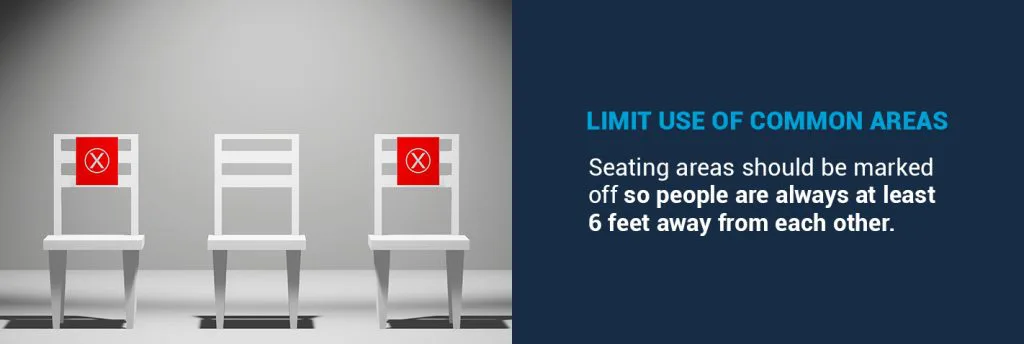

Employers might need to rethink the break room if they want to follow social distancing measures. The best way to encourage social distancing at work is to close off the breakroom and ask employees to socialize over Slack or video conferencing during their break periods. If that’s not a feasible option — for example, if employees have nowhere else to take their lunch break — then the break area should be set up to encourage physical distance between workers. Seating areas should be marked off so people are always at least 6 feet away from each other. You might also install occupancy monitors at the entrance of the break room so employees can see how many people are inside and if it is safe to go in.
Stores that sell clothing might need to rethink their approach to try-ons. One option is to prohibit customers from trying on garments in-store. Encourage people to buy the items they are interested in, try them on at home and return them if they aren’t a good fit. To make the situation more convenient for people, a store can extend the return period. If a store does decide to open fitting rooms, occupancy monitoring can help limit the number of people in the area at any time. If the fitting rooms are full, shoppers can be encouraged to take a remote buzzer and to continue browsing while they wait, instead of forming a line in a small area. When a room becomes available, the buzzer will alert the shopper and they can head back over to the fitting room.
In stores and offices, elevators are another area where social distancing can be challenging. Encourage people to take the stairs if they are capable of doing so. That way, the elevators will be left free for people who need them. Social distancing inside an elevator isn’t practical, so people should take them either one at a time or with other members of their household.
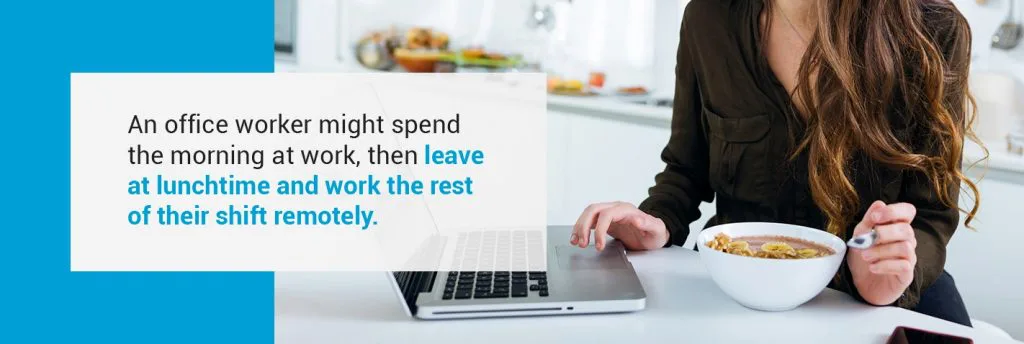

Social distancing in the workplace should also include encouraging people to social distance outside of the workplace. One way to do that is to ask people to bring a bagged lunch with them to work, rather than going out to eat in a restaurant or using the company cafeteria. Another way to limit employees’ contact with other people is to schedule shifts so that people are home for meals, rather than in the office or workplace.
An office worker might spend the morning at work, then leave at lunchtime and work the rest of their shift remotely. Retail establishments and restaurants might decide to schedule employees for four-hour shifts or split their shifts up so there is a significant break in the middle of the day, giving them time to go home and eat.
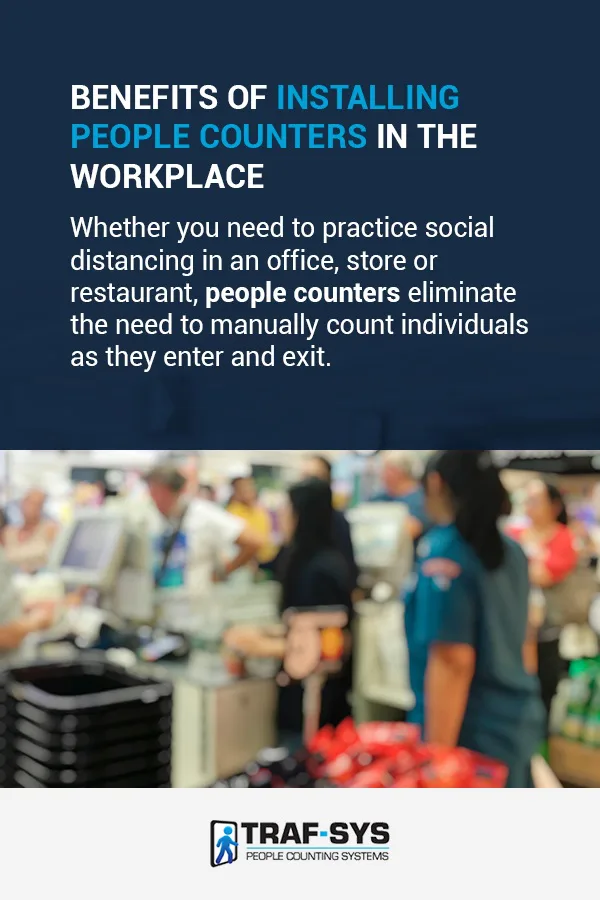

Although rearranging furniture to create more space between individuals at the workplace will help encourage social distancing, the best way to ensure that there is plenty of room between individuals is to control the number of people who are inside an area at any one time. Whether you need to practice social distancing in an office, store or restaurant, people counters eliminate the need to manually count individuals as they enter and exit.
Beyond helping with social distancing, people counters offer additional benefits to workplaces. Retail establishments can compare the data captured by the devices to the amount of sales they have in a day or week to track a correlation between the number of people who enter a store and the value of the store’s sales. Tracking the number of customers who come into a store or restaurant daily can also help those companies determine how many staff members to have on the floor at a given time.
Non-profit organizations can use the data collected by people counting devices when applying for grants and other sources of funding. The data collected can provide proof of the need or demand for a particular organization’s services. For example, a library can use the information provided by people counting software to argue for a grant to pay for a renovation or expansion or to allow the library to remain open for longer hours on certain days.
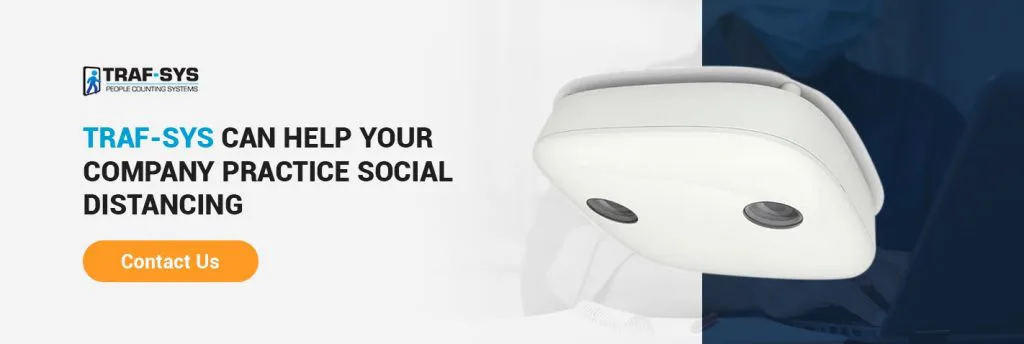

Social distancing in the workplace involves two things: increasing physical space between employees and customers and limiting the number of people in an area at any time. The number of people who can be in your office building, store or restaurant depends in large part on the size of the space and the occupancy limits set up by your city or county.
Keeping track of how many people are inside your workplace at any time is key to social distancing. Traf-Sys offers people counters that keep track of the number of people who come into a building or designated zone and the number who leave. The counters can be installed at each entrance and exit to give you an accurate sense of how many people are in an area at any time. If your company needs to keep track of the number of individuals in a zone to make sure you are complying with occupancy requirements, people counters let you compare the number of bodies in a room or area to the maximum allowed. Using that information, you can let new people come in or ask them to wait outside until someone leaves.
If you need a way to quickly and easily keep track of the number of people in your space, take a look at our product line to see how we can help. We’re also available to answer any questions you have or to help you choose the software program and hardware that will best meet your needs. Contact us today for a free quote.